Download the report (150 p.) - KCE
Download the report (150 p.) - KCE
Download the report (150 p.) - KCE
You also want an ePaper? Increase the reach of your titles
YUMPU automatically turns print PDFs into web optimized ePapers that Google loves.
<strong>KCE</strong> Reports 90 Making General Practice Attractive: Encouraging GP attraction and Retention 97<br />
Table 13: characteristics of <strong>the</strong> interviewed GPs<br />
Type of GPs % N<br />
President or secretary of a 64 20<br />
regional GPs’ circle<br />
Presidents of circles and 23 7<br />
clerkship supervisors<br />
Clerkship supervisors 13 4<br />
Language % N<br />
Dutch-Speaking 48.4 15<br />
French-Speaking 51.6 16<br />
Age groups % N<br />
31-40 6.5 2<br />
41-50 29 9<br />
51-60 61.3 19<br />
61+ 3.2 1<br />
Gender % N<br />
Men 61.3 19<br />
Women 38.7 12<br />
The overall participation rate was 88% (71+31/78+38).<br />
6.5 DATA COLLECTION METHOD<br />
This section is divided into four parts:<br />
6.5.1 Face-to-face interview<br />
• <strong>the</strong> method of interview,<br />
• <strong>the</strong> training of <strong>the</strong> interviewers,<br />
• reaching <strong>the</strong> stakeholders,<br />
• unfolding of <strong>the</strong> interviews.<br />
This study used a CAPI (computer-assisted personal interview). However, MCM is a<br />
ra<strong>the</strong>r sophisticated technique and it was necessary to provide help to <strong>the</strong> interviewee<br />
by an interviewer. He/she was reading and whe<strong>the</strong>r required, explained <strong>the</strong> questions<br />
while <strong>the</strong> interviewee was answering on <strong>the</strong> laptop 200 .<br />
6.5.2 Training of <strong>the</strong> interviewers<br />
The 102 interviews had to be conducted within a period of maximum three months<br />
(from May 2008 until July 2008). Five interviewers followed a standardized training to<br />
interview all stakeholders in <strong>the</strong> same way. The training simulated interviews following<br />
<strong>the</strong> interview guide (see appendix 5.9. and 5.10).<br />
6.5.3 Reaching <strong>the</strong> stakeholders<br />
A letter signed by all main researchers, invited <strong>the</strong> stakeholders to participate. A few<br />
days later, phone contacts confirmed <strong>the</strong>ir agreement to participate and fixed <strong>the</strong> time<br />
for <strong>the</strong> interview. If <strong>the</strong> selected stakeholder did not want to participate, he/she was<br />
asked to name a proxy.<br />
6.5.4 Unfolding of <strong>the</strong> interviews<br />
The average duration time of <strong>the</strong> interview was 49 minutes: 20% lasted less than 40<br />
minutes, 30% lasted between 41-60 minutes and 50% lasted more than 1 hour. During<br />
<strong>the</strong> interviews, <strong>the</strong> interest of <strong>the</strong> stakeholders and <strong>the</strong>ir understanding of <strong>the</strong> questions<br />
were observed and rated by <strong>the</strong> interviewers. Most of <strong>the</strong> stakeholders (87%) had a<br />
good to a very good interest for <strong>the</strong> questionnaire and a good to a very good<br />
understanding of <strong>the</strong> questionnaire (83%).
















